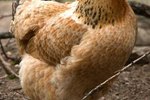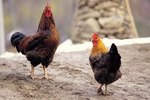
In nature, geese pairs bond and stay together for life. In commercial flocks, a gander -- the male -- is generally paired with three to four females. Once a gander has his harem set up, it shouldn't be changed. It takes some time for domestic geese to take on new mates, although it will eventually occur.
Wild Geese
Most species of wild geese mate for life, although a surviving bird will find another mate if the original partner dies. The Canada goose is the most common and best-known of wild geese species in North America. These geese begin mating and reproducing at the age of 3 years. Mating season extends from mid-winter to early spring. Signs that mating will soon occur include neck-dipping behavior, in which both male and female move their necks up and down. Males court females, but the female makes the decision as to who will be her mate. Once chosen, males become protective of their mates and fight off other males who want to pursue her.
Sexing Geese
If you intend to breed geese, you need to identify the genders. It's not always easy to tell the difference in young birds. The gander is generally larger than the goose. He usually has a bigger head and neck. Depending on the breed, the gander is often a lighter shade than the goose. Listen to your geese. The gander's voice is actually higher than the goose's. Her voice is usually harsher.
Mating Behavior
Just as people generally shower and change into clean clothes before heading out on a date, geese clean themselves up before breeding. They might preen or take a good dust bath. A gander's pre-mating behavior also consists of wing spreading, stretching and flapping, along with gentle and aggressive pecking of his mate. He then mounts and copulates. During breeding season, a mated pair might copulate at least five times a day.
Nesting and Laying Eggs
Like their wild cousins, domestic geese are hardy birds. You can keep breeding pairs or groups outdoors in all but the worst weather, as long as they're safe from predators. Provide nest boxes filled with hay or straw for the goose to lay her eggs. Depending on the species, geese incubate eggs between 29 and 35 days. If you keep other poultry species, you might want to remove the goose eggs shortly after they are laid and place them under broody hens or ducks. Domestic geese tend to be less maternal than other types of fowl.
References
Photo Credits
-
Ablestock.com/AbleStock.com/Getty Images
Writer Bio
Jane Meggitt has been a writer for more than 20 years. In addition to reporting for a major newspaper chain, she has been published in "Horse News," "Suburban Classic," "Hoof Beats," "Equine Journal" and other publications. She has a Bachelor of Arts in English from New York University and an Associate of Arts from the American Academy of Dramatics Arts, New York City.




